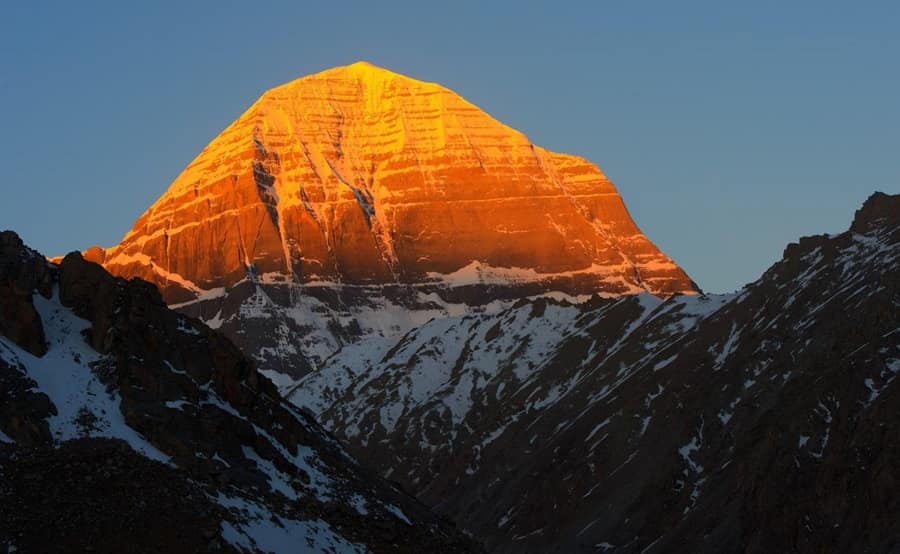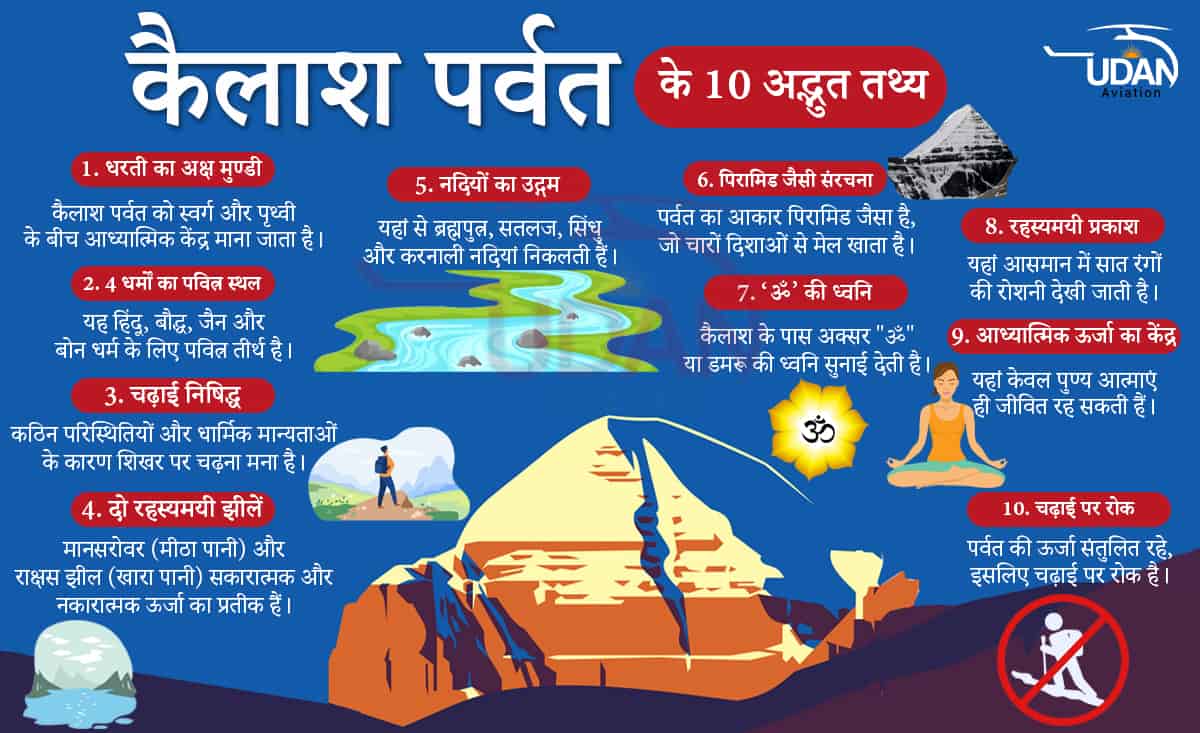Mount Kailash is one of the most sacred destinations in the world known to be the sacred abode of Lord Shiva. It is also a pilgrimage destination for
Mount Kailash is one of the most sacred destinations in the world known to be the sacred abode of Lord Shiva. It is also a pilgrimage destination for Jains, Buddhists, and followers of the Bon religion. It is situated in Tibet’s remote area and is also known to be the “Stairway to Heaven”. The mountain has four unique faces in different directions. These faces are believed to be constructed of gold, crystal, ruby, and lapis lazuli. The pilgrimage to Kailash is called kora or parikrama and it involves walking around the sacred mountain. This spiritual journey brings great spiritual benefits, leads to liberation (moksha), and cleanses sins. Nearby the holy Mount Kailash, Mansarovar Lake is situated where you can take a holy dip to wash away your sins and attain salvation.
The Kailash Yatra can be undertaken both via helicopter journey and on foot trekking through some of the most challenging treks. If you do not want to undertake the trek you can opt for a helicopter yatra that eliminates the need for traditional trekking. As you undertake the Mount Kailash yatra you’ll experience a connection with the divine and attain enlightenment. Join us on this sacred journey to experience the divine power of Lord Shiva and admire the breathtaking Himalayan scenery.
Mysteries and Legends of Mount Kailash:
- The Hindus believe that the Kailash Parvat is Lord Shiva and Parvati’s sacred abode. While the Tibetan Buddhist believes that the sacred mountain is the abode of Demchog, the tantric meditational deity. According to Jains Kailash is the place where nirvana was attained by their first Tirthankar. Bon believes it to be the center of the world, a sacred mountain and home of all gods.
- No one is allowed to climb Mount Kailash as it is believed to be sacred in all four religions and if you attempt to trek at the top it could hurt the people’s religious sentiments. The fear of trespassing the mountain’s sanctity and disturbing the divine energies that reside there makes it unclimbable as it is believed to be the abode of Lord Shiva.
Short Itinerary
- Day 01: Meet our representative at Kathmandu Airport and get transferred to your hotel.
- Day 02: Free Day/ Chinese Visa Processing
- Day 03: Kathmandu Valley’s half-day sightseeing
- Day 04: Chinese Visa Collection Day (Leisure Day)
- Day 05: Kathmandu Drive to Timure 1900m (Nepal/China Border) or Syapru Besi (1450M). (About 8 hours’ drive/152 Km)
- Day 06: Scenic drive to Kerung (2900 M)
- Day 07: Leisure time at Kerung
- Day 08: Drive to Saga 4450m Pass/232km (Labug-La 5050m)
- Day 09: Saga (4,600m.) Embark on a picturesque drive to Mansarovar (4558m/14950 ft)
- Day 10: Worship the bank of Mansarovar – then embark on a drive to Darchen
- Day 11: Trek to Derapuk and Darchen Drive to Yamadwar (05-06 Hours Trek, 4900 Meters –12 Km)
- Day 12: Dira Phuk Trek to – Zutul Puk via Dolma La Pass (8-9 hours Trek, 5630m Meters, 22 Km)
- Day 13: Zutul Phuk – End Kailash Kora- Head back to Saga
- Day 14: Drive back from Saga to Kerung
- Day 15: Drive back from Kerung to Kathmandu 192km
- Day 16: Return to your home from Kathmandu, Airport drop
Places to Visit During the Kailash Mansarovar Yatra
Here are some of the sacred places to visit during Kailash Yatra:
Lake Mansarovar
- This beautiful, freshwater lake is considered to have immense spiritual power.
- Many devotees take a dip in its water to wash away their sins.
- Surrounded by mountains, it is a peaceful spot for meditation and reflection.
Rakshas Tal
- It is shrouded in history and myth and is also known as the Lake of Demons.
- This saltwater lake is believed to be Ravana’s dwelling place.
- The lake comprises four islands including Topserma, Dola, Lachato, and Dosharba.
- You are not allowed to take a bath in this lake as it is considered to be poisonous.
Yam Dwar (Gateway to the God of Death)
- Yam Dwar is known to be Mount Kailash Parikrama’s starting point.
- It serves as a gateway to divine communion and enlightenment.
- One needs to pass through Yam Dwar because it is believed that after crossing this gateway of Yamraj, they are liberated from their past sins and freed from the negative energy surrounding them.
Dirapuk Monastery
- The monastery is situated near Mount Kailash and offers a breathtaking view of the mountain’s Northside.
- The main attraction of this monastery is Avalokiteshvara. Behind the main chapel, there is a meditation cave, where you can meditate
Zuthulphuk Monastery
- Also known as Zuthulphuk Gompa, this monastery is known for its peaceful environment and spiritual vibes.
- On the kora, it is the final monastery before returning to Kailash Parvat Tour.

Challenges of the Mount Kailash Yatra
- Altitude sickness is a common concern for those traveling to Mount Kailash due to the high altitudes. Due to low oxygen levels, you may have difficulty breathing. You’re advised to acclimatize yourself before undertaking this yatra.
- Due to unpredictable weather and rugged terrain, you may have to face challenges such as altitude sickness, injuries, and fatigue without proper preparation. You should be well-equipped for the yatra with first-aid supplies, appropriate clothing, and a fit body to endure the trek.
- The healthcare facilities are limited as Mount Kailash is situated in a remote region and you may also have to deal with unexpected delays and cancellations.
- The Kora around Kailash is very demanding physically because of its steep inclines, high elevation, and rugged terrain. However, by staying well-prepared, including acclimatization and physical training, you can successfully finish the Kora.
Accommodation
During Mount Kailash Yatra you can choose different types of accommodation depending on your preference. You will typically find three types of accommodation: camping, guest houses, and hotels. Hotels are the best option, providing a rejuvenating experience with private washrooms, cozy beds, and many other amenities. Similarly, lodges and guest houses offer basic facilities like mattresses, shared bathrooms, and blankets. Finally, camping is a great choice for trekkers who want to experience the beauty of the Kailash region. If you opt for lodges and hotels, you’re recommended to book them in advance to avoid any kind of stress at the last minute.
- Also Read: Best Time To Visit Kailash Mansarovar
Travel Tips for the Yatra
Here are some essential travel tips to help you prepare for this sacred journey:
- Get yourself examined medically by a qualified doctor to ensure you do not have any major health complications. Prepare in advance for the yatra with brisk walking, yoga asanas, regular exercise, and pranayama.
- During the yatra, with the decreasing oxygen level and increasing altitude, the travelers must drink plenty of juices or water, etc, eat well, and take proper rest to get acclimatized for a comfortable and safe journey.
- Carry a first aid kit and regular medicines for loose motion, cold, fever, body aches, headache, bandage, etc. If you take other medicines regularly, you should carry them for an extended duration of the yatra.
- Dress up in layers and carry a sufficient amount of warm clothing during the yatra to stay protected from the cold weather.
FAQs
Q-1: What is the best time to visit Mount Kailash?
Ans: Autumn (September to October) and Spring (May to June) are the best time to visit Mount Kailash, offering stunning views, high visibility, and comfortable temperatures. You should avoid traveling during the monsoon due to heavy rain and slippery paths.
Q-2: Can you climb Mount Kailash?
Ans: No, you’re not allowed to climb Mount Kailash as it is considered to be sacred by followers of different religions. The fear of trespassing the mountain’s sanctity and disturbing the divine energies that reside there makes it unclimbable as it is believed to be the abode of Lord Shiva.
Q-3: How difficult is the Mount Kailash Yatra?
Ans: The Mount Kailash yatra is difficult as it involves dealing with changing weather conditions, trekking rugged terrains, and acclimatizing yourself to the high altitude. The trek is quite challenging as it includes difficult descents and ascents, especially throughout the 52-kilometer circumambulation of Mount Kailash.
Q-4: What is the cost of the Kailash Mansarovar Yatra?
Ans: The Kailash Mansarovar Yatra cost depends on different factors. You need a Tibet visa fee and a Tibet travel permit, which makes the trip a bit expensive. Depending on the size of the group, the price of the yatra will be USD 2750 per person for a group comprising more than 25 people. For a private group comprising 11 to 16 people, the Yatra will cost USD 3500 per person.
Q-5: What permits are required for Kailash Mansarovar Yatra?
Ans: Since Kailash Mansarovar is situated in Tibet and travel is restricted you need to obtain different types of entry permits from the concerned authorities in Tibet and Lhasa. Such permits can’t be obtained by travellers directly and you need to join a group tour and apply through authorized agencies for the permits. The permit process may take three to four weeks as it is lengthy.

COMMENTS